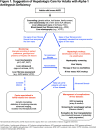Non-Invasive Assessment and Management of Liver Involvement in Adults With Alpha-1 Antitrypsin Deficiency
- PMID: 32697896
- PMCID: PMC7857717
- DOI: 10.15326/jcopdf.7.3.2019.0161
Non-Invasive Assessment and Management of Liver Involvement in Adults With Alpha-1 Antitrypsin Deficiency
Abstract
Alpha-1 antitrypsin deficiency (AATD) is a systemic disorder affecting mainly the lung and the liver and is caused by mutations in SERPINA1, the AAT gene. A homozygous "Pi*Z" mutation (Pi*ZZ genotype) may cause liver fibrosis on its own independently of pulmonary AATD manifestation, while heterozygous Pi*Z carriage (Pi*MZ genotype) is considered a strong risk factor for development of liver cirrhosis in patients with concomitant liver disease such as alcoholic and non-alcoholic liver disease. In Pi*ZZ homozygotes, liver disease constitutes the second leading cause of death and is highly heterogeneous. About 35% of Pi*ZZ individuals display significant liver fibrosis on biopsy (i.e., fibrosis stage ≥ 2 on scale 0-4). Among non-invasive methods for liver fibrosis assessment, liver stiffness measurement (LSM) via vibration-controlled transient elastography (VCTE) has been most widely evaluated. Based on these data, Pi*ZZ adults have 20x increased odds of developing advanced liver fibrosis (i.e., fibrosis stage ≥ 3) than adults without AAT mutation. Risk factors for accelerated fibrosis progression are male sex, age ≥ 50 years, alcohol misuse, obesity, diabetes mellitus, or metabolic syndrome. Unlike VCTE, other ultrasound- and magnetic resonance-based elastography methods have been assessed in small cohorts of Pi*ZZ individuals and remain to be comprehensively validated. Among blood-based fibrosis tests, AST-to-platelet ratio index (APRI) correlates moderately with histologic fibrosis stage and LSM. Given APRI's wide availability, it can be used for risk stratification as an adjunct to LSM or when LSM is not at hand. Despite recent efforts, AATD-related liver disease, especially for genotypes other than Pi*ZZ, remains greatly understudied. AATD individuals should be offered liver biochemistry, liver ultrasound, and non-invasive fibrosis assessment at the time of diagnosis to detect potential complications and for proper risk stratification. If signs of AATD-related liver disease occur (i.e., pathologic fibrosis test or repeatedly elevated liver enzymes), patients should be referred to a health care center specialized in AATD-related liver disease and be screened for potentially treatable comorbidities. To exclude the latter, they may need a liver biopsy. Moreover, every health care provider of an AATD individual should be aware of the potential liver manifestation, counsel their patient on modifiable hepatic risk factors, and offer them regular liver check-ups.
Keywords: AATD; SERPINA1; alpha-1 antitrypsin deficiency; elastography; genetic liver disease; liver fibrosis; liver stiffness; rare liver disease.
JCOPDF © 2020.
Conflict of interest statement
PS has received speaker or consulting fees from Grifols, CSL Behring, Alnylam, and Arrowhead Pharmaceuticals. KH has received speaker fees from CSL Behring.
Similar articles
-
Liver Fibrosis and Metabolic Alterations in Adults With alpha-1-antitrypsin Deficiency Caused by the Pi*ZZ Mutation.Gastroenterology. 2019 Sep;157(3):705-719.e18. doi: 10.1053/j.gastro.2019.05.013. Epub 2019 May 20. Gastroenterology. 2019. PMID: 31121167
-
Alpha-1 Antitrypsin Augmentation and the Liver Phenotype of Adults With Alpha-1 Antitrypsin Deficiency (Genotype Pi∗ZZ).Clin Gastroenterol Hepatol. 2024 Feb;22(2):283-294.e5. doi: 10.1016/j.cgh.2023.08.038. Epub 2023 Sep 15. Clin Gastroenterol Hepatol. 2024. PMID: 37716616
-
Clinical and histologic features of adults with alpha-1 antitrypsin deficiency in a non-cirrhotic cohort.J Hepatol. 2018 Dec;69(6):1357-1364. doi: 10.1016/j.jhep.2018.08.005. Epub 2018 Aug 21. J Hepatol. 2018. PMID: 30138687
-
Cleaning up alpha-1 antitrypsin deficiency related liver disease.Curr Opin Gastroenterol. 2023 May 1;39(3):163-168. doi: 10.1097/MOG.0000000000000919. Epub 2023 Mar 1. Curr Opin Gastroenterol. 2023. PMID: 37144533 Review.
-
Hereditary alpha-1-antitrypsin deficiency and its clinical consequences.Orphanet J Rare Dis. 2008 Jun 19;3:16. doi: 10.1186/1750-1172-3-16. Orphanet J Rare Dis. 2008. PMID: 18565211 Free PMC article. Review.
Cited by
-
Future Perspectives in the Diagnosis and Treatment of Liver Disease Associated with Alpha-1 Antitrypsin Deficiency.GE Port J Gastroenterol. 2023 Feb 1;30(5):327-335. doi: 10.1159/000528809. eCollection 2023 Oct. GE Port J Gastroenterol. 2023. PMID: 37868641 Free PMC article. Review.
-
Utility of Transient Elastography for the Screening of Liver Disease in Patients with Alpha1-Antitrypsin Deficiency.J Clin Med. 2021 Apr 16;10(8):1724. doi: 10.3390/jcm10081724. J Clin Med. 2021. PMID: 33923569 Free PMC article.
-
Alpha-1 antitrypsin deficiency and Pi*Z allele as important co-factors in the development of liver fibrosis.World J Hepatol. 2024 Aug 27;16(8):1099-1110. doi: 10.4254/wjh.v16.i8.1099. World J Hepatol. 2024. PMID: 39221093 Free PMC article.
-
Liver disease with unknown etiology - have you ruled out alpha-1 antitrypsin deficiency?Ther Adv Chronic Dis. 2021 Jul 29;12_suppl:2040622321995684. doi: 10.1177/2040622321995684. eCollection 2021. Ther Adv Chronic Dis. 2021. PMID: 34408828 Free PMC article. Review.
-
A stacking ensemble machine learning model to predict alpha-1 antitrypsin deficiency-associated liver disease clinical outcomes based on UK Biobank data.Sci Rep. 2022 Oct 11;12(1):17001. doi: 10.1038/s41598-022-21389-9. Sci Rep. 2022. PMID: 36220873 Free PMC article.
References
-
- Ge PS,Runyon BA. Treatment of patients with cirrhosis. N Engl J Med. 2016;375:767-77. doi: https://doi.org/10.1056/NEJMra1504367 - PubMed
-
- Zoubek ME,Trautwein C,Strnad P. Reversal of liver fibrosis: from fiction to reality. Best Pract Res Clin Gastroenterol. 2017;31(2):129-141. doi: https://doi.org/10.1016/j.bpg.2017.04.005 - PubMed
-
- Angulo P,Kleiner DE,Dam-Larsen S,et al. Liver fibrosis, but no other histologic features, is associated with long-term outcomes of patients with nonalcoholic fatty liver disease. Gastroenterology. 2015;149(2):389-397.e10. doi: https://doi.org/10.1053/j.gastro.2015.04.043 - PMC - PubMed
-
- Ekstedt M,Hagstrom H,Nasr P,et al. Fibrosis stage is the strongest predictor for disease-specific mortality in NAFLD after up to 33 years of follow-up. Hepatology. 2015;61(5):1547-1554. doi: https://doi.org/10.1002/hep.27368 - PubMed
-
- Tapper EB,Lok AS. Use of liver imaging and biopsy in clinical practice. N Engl J Med. 2017;377:756-768. doi: https://doi.org/10.1056/NEJMra1610570 - PubMed
Publication types
Grants and funding
LinkOut - more resources
Full Text Sources
Research Materials
Miscellaneous

